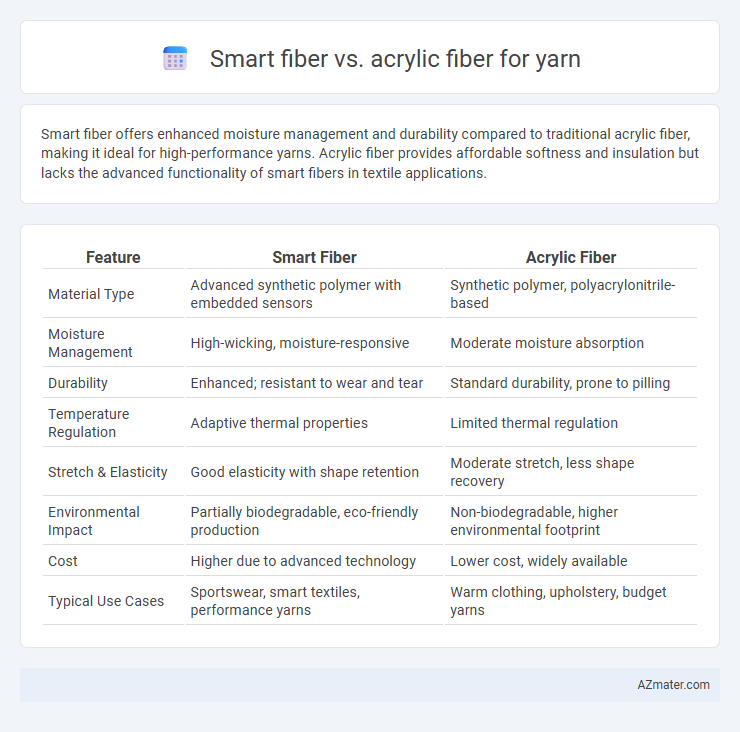Smart fiber offers enhanced moisture management and durability compared to traditional acrylic fiber, making it ideal for high-performance yarns. Acrylic fiber provides affordable softness and insulation but lacks the advanced functionality of smart fibers in textile applications.
Table of Comparison
| Feature | Smart Fiber | Acrylic Fiber |
|---|---|---|
| Material Type | Advanced synthetic polymer with embedded sensors | Synthetic polymer, polyacrylonitrile-based |
| Moisture Management | High-wicking, moisture-responsive | Moderate moisture absorption |
| Durability | Enhanced; resistant to wear and tear | Standard durability, prone to pilling |
| Temperature Regulation | Adaptive thermal properties | Limited thermal regulation |
| Stretch & Elasticity | Good elasticity with shape retention | Moderate stretch, less shape recovery |
| Environmental Impact | Partially biodegradable, eco-friendly production | Non-biodegradable, higher environmental footprint |
| Cost | Higher due to advanced technology | Lower cost, widely available |
| Typical Use Cases | Sportswear, smart textiles, performance yarns | Warm clothing, upholstery, budget yarns |
Introduction to Smart Fiber and Acrylic Fiber
Smart fiber, engineered with advanced polymers, offers superior moisture-wicking, breathability, and durability compared to traditional fibers. Acrylic fiber, a synthetic fiber made from polymerized acrylonitrile, is valued for its wool-like feel, lightweight nature, and resistance to mildew and sunlight. Both fibers are widely used in yarn production, with smart fibers driving innovation in performance textiles and acrylic fibers maintaining popularity for their affordability and versatility.
Key Differences Between Smart Fiber and Acrylic Fiber
Smart fiber yarn incorporates advanced technology for enhanced moisture management, breathability, and durability, making it ideal for performance and high-tech textiles. Acrylic fiber yarn is a synthetic material known for its lightweight, soft texture, resistance to UV rays, and affordability, commonly used in sweaters and upholstery. Key differences include smart fiber's superior moisture-wicking capabilities and longer lifespan compared to acrylic's cost-effectiveness and better colorfastness.
Manufacturing Process of Smart Fiber vs Acrylic Fiber
Smart fiber manufacturing involves advanced processes such as electrospinning or incorporating nanomaterials to enhance functionality like moisture management and thermal regulation, resulting in fibers with superior performance characteristics. Acrylic fiber production uses chemical polymerization of acrylonitrile monomers followed by dry or wet spinning to form synthetic fibers known for softness and durability. The integration of smart technologies in fiber formation differentiates smart fibers from conventional acrylic fibers in terms of manufacturing complexity and end-use capabilities.
Durability and Strength Comparison
Smart fiber yarn exhibits superior durability compared to acrylic fiber due to its advanced molecular structure that resists wear and tear under heavy use. Acrylic fiber, while lightweight and inexpensive, tends to weaken and pill over time, reducing its overall strength and lifespan. Smart fibers maintain tensile strength and elasticity longer, making them ideal for high-performance textile applications where durability is critical.
Comfort and Softness: Which is Better?
Smart fiber yarn outperforms acrylic fiber in comfort and softness due to its advanced moisture-wicking properties and superior breathability, which keep the skin dry and cool. Acrylic fiber tends to be less breathable and can retain heat, causing discomfort during prolonged wear. The finer, smoother texture of smart fibers results in a softer feel, making it the preferred choice for garments that prioritize comfort.
Thermal Properties and Insulation
Smart fiber exhibits superior thermal properties compared to acrylic fiber, offering enhanced heat retention and faster moisture-wicking capabilities that improve insulation efficiency in yarn applications. Its advanced polymer structure provides optimal breathability while maintaining warmth, making it ideal for temperature-regulating textiles. Acrylic fiber, though effective in insulation, generally falls short in moisture management and thermal responsiveness, resulting in lower overall performance in thermal comfort.
Sustainability and Environmental Impact
Smart fiber yarns, often made from biodegradable or recycled materials, present significant sustainability advantages over traditional acrylic fibers, which are synthetic and derived from petroleum. Compared to acrylic fibers, smart fibers reduce ecological footprints by minimizing microplastic pollution and energy consumption during production. Choosing smart fiber yarns supports eco-friendly textile manufacturing and contributes to lower landfill waste and carbon emissions.
Cost Efficiency of Smart Fiber vs Acrylic Fiber
Smart fiber yarns typically offer higher cost efficiency compared to acrylic fibers due to their enhanced durability and lower maintenance requirements, resulting in reduced long-term expenses. While acrylic fibers have a lower initial purchase price, their shorter lifespan and susceptibility to wear increase replacement costs over time. The investment in smart fiber technology yields better value in textile production by minimizing material waste and improving product longevity.
Ideal Applications for Each Fiber Type
Smart fiber yarns are ideal for performance textiles, activewear, and medical applications due to their moisture-wicking, temperature-regulating, and antimicrobial properties. Acrylic fiber yarns excel in affordable fashion, home furnishings, and outdoor wear because of their softness, lightweight nature, and excellent resistance to sunlight and weathering. Choosing smart fibers ensures advanced functionality, while acrylic fibers provide cost-effective durability and comfort.
Conclusion: Choosing the Right Yarn Fiber
Smart fiber offers enhanced durability, moisture-wicking, and elasticity, making it ideal for performance-oriented and high-end apparel. Acrylic fiber provides affordability, softness, and warmth, suitable for budget-friendly and casual wear applications. Selecting the right yarn fiber depends on the end-use requirements, balancing factors like durability, comfort, and cost.

Infographic: Smart fiber vs Acrylic fiber for Yarn
 azmater.com
azmater.com